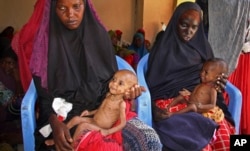This is not Somalia's first drought and it likely won't be its last.
The government announced Saturday that 110 people had died in a two-day period due to drought-induced famine, particularly in the Bay and Bakol regions, highlighting the need not just for rapid emergency response to this crisis, but also long-term solutions to prevent food insecurity.
And some aid groups say ongoing conflict in Somalia has left it more vulnerable as long-term resilience programs are more challenging to properly implement there.
Daniel O'Malley, deputy head of the Somalia delegation for the International Committee of the Red Cross, argues that Kenya and Ethiopia are also suffering from drought, but in those countries there is a social safety net.
"I mean, it's a country that's in conflict," O'Malley said of Somalia. "It's a country that we have intra-clan conflict. We've had conflict between different regions and, obviously, we cannot forget that, especially in the center and south. We have a big presence of non-state actors, which do have an influence on the possibility of longer-term projects or development [plans]."
Hassan Noor Saadi is the country director for the Somalia office of Save the Children. He says that while Ethiopia's drought last year affected almost 20 million people, that country fared much better because a lot of resilience work has been taking place under a certain level of stability, which has not been the case in Somalia.
"So with the current level of instability, in terms of conflict and in terms of social services that are available, any resilience work can be quite challenging," Saadi said. "But I would also not want to completely say that it would not matter because in the last five, six years, a lot of resilience work has been done in Somalia and that work has allowed the populations to withstand at least medium-sized shocks."
Mercy Corp's regional program director for East and Southern Africa, Darius Radcliffe, agrees that resilience programs work best when there isn't conflict, but says that doesn't mean they don't work when there is. And, he adds, not all of Somalia is conflict-ridden.
"Well, all of Somalia isn't under the control of al-Shabab, so there's definitely several, a lot of pockets of areas that are somewhat stable," Radcliffe said. "These are areas that you could work in, and you could apply those resilience approaches."
The ICRC, Save the Children, and Mercy Corps are all working in Somalia on various projects involving livelihoods, water, irrigation, health and education, among others.
Famine has been declared in parts of South Sudan only, but the World Food Program has projected that 20 million people are at risk of dying from starvation in the next six months in South Sudan, Somalia, Yemen and northern Nigeria.









